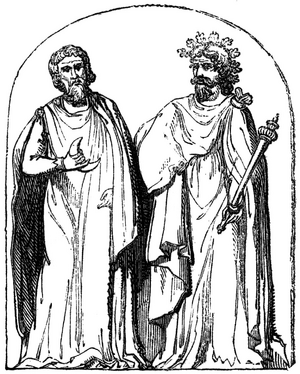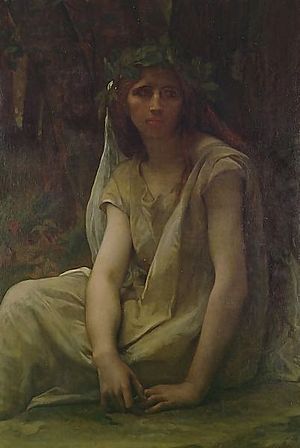Druid facts for kids
A druid was a very important person in ancient Celtic societies. These societies existed in parts of Western Europe, Britain, and Ireland. Druids were active before the Roman government took over and before Christianity arrived.
Druids were part of the cultures of tribal peoples. The Greeks called these people "Keltoi" or "Keltai," and the Romans called them "Celtae." In their communities, druids had many jobs. They were like priests, judges, healers, and teachers. They also helped solve problems between people. Both men and women could be druids, though early records mostly mention men.
Druids did not write down their knowledge. Historians think they knew how to write, but they chose to pass down their teachings by speaking. People from other cultures, like the Romans and Greeks, wrote about what the druids believed and did.
The first mentions of druids are from the 4th century BC. The Roman general Julius Caesar wrote the most detailed description in his book Commentarii de Bello Gallico around 50 BCE. Other Roman writers like Cicero and Pliny the Elder also wrote about them. After the Romans invaded Gaul, the Roman government stopped the druid orders. This happened under emperors Tiberius and Claudius in the 1st century CE. By the 2nd century, druids were no longer mentioned in written records.
The Role of Druids in Society
Ancient Greek, Roman, and Irish writings all agree that druids were very important in Celtic society. Julius Caesar wrote that druids were in charge of religious ceremonies and sacrifices. They also predicted the future and handled legal matters in Gaul, Britain, and Ireland.
Caesar also said that druids did not have to serve in the army or pay taxes. They could even stop people from taking part in religious festivals. This made those people social outcasts. Two other writers, Diodorus Siculus and Strabo, said that druids were so respected that they could even stop battles between two armies.
Diodorus described druids as "philosophers" and "men learned in religious affairs" who were highly honored. Pomponius Mela was the first writer to say that druids taught their students in secret. These lessons often took place in caves and forests.
Druids learned a lot of information by heart, including many verses. Caesar noted that it could take up to twenty years to finish their training. All their teaching was done by speaking, not writing. However, for everyday things, the Gauls did use a written language. They used Greek letters for this.
Caesar believed that druids kept their knowledge oral for two reasons. First, they wanted to keep their special knowledge secret. Second, they thought it would help them remember things better.
Druids in Ancient Stories
Druids are very important characters in Irish folklore. They often served kings as wise advisors. They had special gifts like being able to predict the future and other magical abilities.
One famous mythological druid was Cathbad. He was the chief druid in the court of King Conchobar mac Nessa of Ulster. Cathbad appears in many stories, often showing his power to see what will happen. For example, in the story of Deirdre of the Sorrows, Cathbad predicted that Deirdre would grow up to be very beautiful. He also said that kings would fight over her, and much blood would be shed. This prophecy came true, even though the king ignored it.
Perhaps the greatest mythological druid was Amergin Glúingel. He was a bard (a poet and storyteller) and a judge for the Milesians. In the Mythological Cycle stories, the Milesians wanted to take over Ireland from the Tuatha Dé Danann. But the druids of the Tuatha Dé Danann created a magical storm to stop their ships. Amergin then called upon the spirit of Ireland itself. He chanted a powerful song known as The Song of Amergin. After successfully landing, he helped his royal brothers divide the land of Ireland. He earned the title Chief Ollam of Ireland, which was a very high honor.
Other famous mythological druids include Tadg mac Nuadat from the Fenian Cycle and Mug Ruith, a powerful blind druid from Munster.
Images for kids
-
A headdress from the "Deal Warrior", possibly worn by druids, found in Britain.
See also
 In Spanish: Druida para niños
In Spanish: Druida para niños






